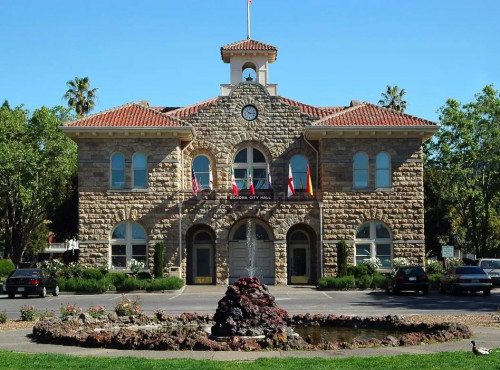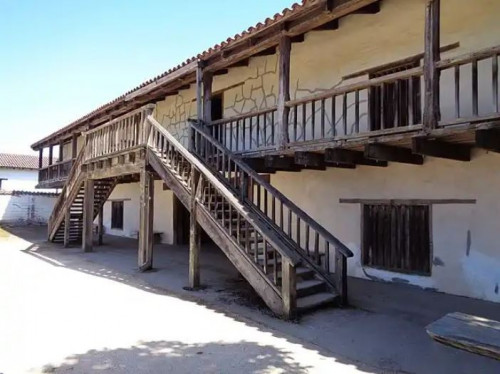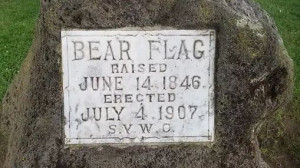The Town of Sonoma
- Genealogy
- History of Sonoma
- The Town Today
- Places of Interest
- People of Interest
- Maps
- Photos
Table of Contents
Sonoma is a city in Sonoma County, California, located in the North Bay region of the San Francisco Bay Area. Sonoma is one of the principal cities of California's Wine Country and the center of the Sonoma Valley AVA. Sonoma's population was 10,739 as of the 2020 census, while the Sonoma urban area had a population of 32,678. Sonoma is a popular tourist destination, owing to its Californian wineries, noted events like the Sonoma International Film Festival, and its historic center. [1]
Genealogy
Gedcom Index for Sonoma, CA. . . . Link . . . Link
Surnames: Abbot, Bouse, Carpenter, Fields, Fitch, Grant, Greenlee, Hoebeken, Kelly, Metcalf, Rainey, Rea, Rogers, Ross, Royer, Runner, Smith, Sohlke, Stapleton, Younger, Wiederhol
GenealogyOnline:
About the Town Sonoma . . . Link
Surnames:
Anderson, Barnes, Blomer,
Brockman, Cannon, Carriger, Coon, Corbin, Geervliet,
Hertlein, Hutchison, Jackson, Kent, Kinder, Kreun, Lowe,
Lundy, Marmaduke, Massey, Panas, Roberts, Runner,
Schaad, Smith, Smolensky (solen), Spaulding, Stefani,
Strode, Todd, Wassenaar
LDS genealogy.com: Sonoma . . . Link
Roadside Thoughts: Sonoma California . . . Link
Sonoma
County Genealogical Society . . . Link
The web site "The Cockrill Family of Sonoma County" [Link] has a wonderful collection of local genealogy including the following with ties to this town: Since this page is about "Sonoma County" I can't get it to search for just Sonoma town, so there are over 200 hits.
History
of Sonoma
When the first Europeans arrived, the area was near the northeast corner of the Coast Miwok territory, with Southern Pomo to the northwest, Wappo to the northeast, Suisunes and Patwin peoples to the east. [1]
Sonoma's origins date to 1823, when José Altimira established Mission San Francisco Solano, under the direction of Governor Luis Antonio Argüello. Following the Mexican secularization of the missions, famed Californio statesman Mariano G. Vallejo founded Sonoma on the former mission's lands in 1835. Sonoma served as the base of General Vallejo's operations until the Bear Flag Revolt in 1846, when American filibusters overthrew the local Mexican government and declared the California Republic, ushering in the American Conquest of California. [1]
[More Wikipedia History down further.]
Sonoma
In 1835 the Mexican
government, which had succeeded Spanish rule, sent Lt.
Mariano G. Vallejo to Sonoma to establish a military post,
to deter the Russians at Fort Ross from encroaching
farther south, to oversee the secularization of the
mission, and to lay out the pueblo of Sonoma. In the
center of Sonoma is an eight acre plaza laid out by
Vallejo. Nearby, Vallejo constructed barracks for his
troops and an adjoining multi-storied Casa Grande.
Immediately surrounding the Plaza were a number of
historic structures, including the Mission, Vallejo's
barracks, the homes of several dignitaries, including
Colonel Joe Hooker, the Union Hotel and Green's
courthouse. Mexican rule ended here in 1846, when local
settlers raided the military post, taking Vallejo
prisoner. They proclaimed the independence of California
with the raising of the Bear Flag over the Sonoma Plaza.
The residence of Gen. G. Yallejo was demolished in 1856,
and an elegant hotel erected on the spot. By 1864, the
town of Sonoma had 500 inhabitants. . . . [Archived
Website. Link]
Early History of the California Coast: Sonoma Plaza . . . Link
History of Sonoma (City Page) .
. . Link
Permit Sonoma: Sonoma County Historic Overview . . . Link
Recent History of Sonoma California . . . Link
Story of Sonoma: History You Can Sip . . . Link
Sonoma Valley Historical Society . . . Link . . . Official City Page
Check Sonoma Historian (SCHS) for articles about the towns. .
. . Link
The Town Today
American Towns . . . Link
LocalWiki: Sonoma . . . Link [does not exist yet as I can see] . .
See Also: Pueblo de Sonoma, Sonoma Barracks . . Sonoma & Santa Rosa Railroad, Sonoma Valley Prismoidal Railway, Sonoma Valley Railroad, Valley History
Sonoma Chamber of Commerce . . . Link
Sonoma County Life Opens Up: TOWN. . . Link . . . 48 Hours In
Sonoma Homepage . . . Link . . . County Page . . . Link
Sonoma Today [Niche] (has a map of location) . . . Link
Visit California: Downtown Sonoma . . Link
Wikipedia Page: Sonoma. . . Link
WikiVoyage: Sonoma . . . Link
Places of Interest
Sonoma History & Landmarks . . . Link
Sonoma Mission Inn . . . Link
Sonoma State Historic Park .
. . Link
Unlike most parks with a single plot of land and a continuous boundary, Sonoma State Historic Park is a scattering of historical sites consisting of six midtown locations near Sonoma's Plaza. General Vallejo's Home, also called Lachryma Montis, is less than a mile west of the Plaza. It was the estate of General Mariano Guadalupe Vallejo, Military Commander and Director of Colonization of the Northern Frontier and founder of Pueblo de Sonoma.
Exploring California History In Sonoma . . . Link
Blue
Wing Inn (est. 1836) . . . Link . . . Wikipedia
General Vallejo's Home (1849) . . . Link . . . Parks & Rec . . . Wikipedia
Mission San Francisco Solano (1823). . . Link . . . Wikipedia
Servants Quarters (the remains of La Casa Grande) (1840) . . .
Link . . . Wikipedia
Sonoma Barracks (1835) . . . Link . . . Wikipedia
Toscano Hotel & Kitchen (1852) . . . Link . . . Wikipedia
People of Interest
Christian Frederick Leiding . . . Link
[the Toscano Hotel complex] sold .. to Henry Carl of San Francisco, who sold it to Christian Frederick Leiding the following March. Leiding's Store operated from 1860 to 1877.
General Mariano Guadalupe Vallejo (1807-1890) . . . Link . . . Wikipedia
General Mariano Guadalupe Vallejo was an extraordinary Californio. He founded Sonoma and is remembered today as a great American who contributed a great deal to California both before and after statehood. His life is essentially the history of 19th century Sonoma and his influence is still evident in 21st century Sonoma.
Mrs. M.M. (Dorothea) Nathanson . . . Link
the Toscano Hotel complex was sold by Mariano Vallejo to Mrs. M.M. (Dorothea) Nathanson in 1852. Shortly after the purchase, Mrs. Nathanson constructed a two-story building with surplus lumber from the new Methodist church in Sonoma. The building was first used as a retail store and rental library called Nathanson's.
Stefano Martinoni . . . Link
In November 1898, Stefano Martinoni, Settimo Ciucci's father-in-law, purchased the Toscano for $10.00 in gold coin. The site at this time held the hotel with two one-story rear additions, a small two-story dwelling (now called the Tank House) and a one-story dwelling at the front lot line (now the 2nd floor of the Hotel Annex).
Maps
Map of Sonoma, with boundaries [BingMaps] . . . Link
Map of Sonoma [MapQuest] . . . Link
Photos
Town, 1955 . . . Link
A Whole Lotta More History [Wikipedia, [1]]
Mission Era
Mission San Francisco Solano is the direct predecessor to the founding of Sonoma. The mission, the only to be constructed not by the Spanish but by the Mexican authorities, was built as part of a larger plan Governor Luis Antonio Argüello had devised to fortify Mexican presence north of San Francisco Bay and thus deter Russian encroachment into the region. Franciscan padre José Altimira worked with Governor Argüello to plan the mission, against the desires of José Francisco de Paula Señan, then the President-General of the Californian missions, who disapproved of government intervention into religious matters.
In 1833 the Mexican Congress passed the Mexican secularization act of 1833, effectively nationalizing all the missions and associated lands of the Catholic church in California, which the goal of diminishing the church's highly influential standing in California's economy and political system. Governor José Figueroa appointed Mariano Guadalupe Vallejo, then the Commandant of the Presidio of San Francisco, as administrator (comisionado) to oversee the closing of Mission San Francisco Solano and its conversion into a civilian town.
General Vallejo era
Governor Figueroa had received instructions from the Mexican Congress to establish a strong presence in the region north of the San Francisco Bay to protect the area from encroachments of foreigners. An immediate concern was the further eastward movement of the Russian America Company from their settlements at Fort Ross and Bodega Bay on the California coast.
Figueroa's next step in implementing his instructions was to name Lieutenant Vallejo as Military Commander of the Northern Frontier and to order the soldiers, arms and materiel at the Presidio of San Francisco moved to the site of the recently secularized Mission San Francisco Solano. The Sonoma Barracks were built to house the soldiers. Until the building was habitable, the troops were housed in the buildings of the old Mission. In 1834, George C. Yount, the first Euro-American permanent settler in the Napa Valley, was employed as a carpenter by General Vallejo.
The Governor granted Lieutenant Vallejo the initial lands (approximately 44,000 acres (178 km2)) of Rancho Petaluma immediately west of Sonoma. Vallejo was also named Director of Colonization which meant that he could initiate land grants for other colonists (subject to the approval of the governor) and the diputación (Alta California's legislature).
Vallejo had also been instructed by Governor Figueroa to establish a pueblo at the site of the old Mission. In 1835, with the assistance of William A. Richardson, he laid out, in accordance with the Spanish Laws of the Indies, the streets, lots, central plaza and broad main avenue of the new Pueblo de Sonoma.
Although Sonoma had been founded as a pueblo in 1835, it remained under military control, lacking the political structures of municipal self-government of other Alta California pueblos. In 1843, Lieutenant Colonel Vallejo wrote to the Governor recommending that a civil government be organized for Sonoma. A town council (ayuntamiento) was established in 1844 and Jacobo Leese was named first alcalde, and Cayetano Juárez second alcalde.
Bear Flag Revolt
Before dawn on Sunday, June 14, 1846, thirty-three Americans, already in rebellion against the Alta California government, arrived in Sonoma. Some of the group had traveled from the camp of U.S. Army Brevet Captain John C. Frémont who had entered California illegally in late 1845 with his exploration and mapping expedition. Others had joined along the way. As the number of immigrants arriving in California had swelled, the Mexican government barred them from buying or renting land and threatened them with expulsion because they had entered without official permission. Mexican officials were concerned about the coming war with the United States coupled with the growing influx of American immigrants into California.
A group of rebellious Americans had departed from Frémont's camp on June 10 and captured a herd of 170 Mexican government-owned horses being moved by Californio soldiers from San Rafael and Sonoma to Alta California's Commandante General José Castro in Santa Clara. The insurgents next determined to seize the weapons and materiel stored in the Sonoma Barracks and to deny Sonoma to the Californios as a rallying point north of San Francisco Bay.
Meeting no resistance, they approached the home of General Vallejo, who invited the filibusters' leaders into his home to negotiate terms. However, when the agreement was presented to those outside they refused to endorse it. Rather than releasing the Mexican officers under parole, they insisted they be held as hostages. William Ide gave an impassioned speech urging the rebels to stay in Sonoma and start a new republic. Afterwards, Vallejo and his three associates were taken as prisoners and placed on horseback and taken to Frémont.
The Sonoma Barracks became the headquarters for the remaining
twenty-four rebels, who within a few days created their Bear
Flag. After the flag was raised Californios called the
insurgents Los Osos (The Bears) because of their flag and in
derision of their often scruffy appearance. The rebels
embraced the expression, and their uprising became known as
the Bear Flag Revolt. There were some small unit skirmishes
between the Bears and the Californios but no major
confrontations.
After hearing reports that General José Castro was preparing to attack Sonoma, Frémont left Sutter's Fort with his forces for Sonoma. There he called a meeting with "the Bears" and united his forces with the revolters to form a single military unit. Frémont then took the majority of the men back to Sutter's Fort and left fifty men to defend Sonoma. The Bear Flag Revolt ended and the California Republic ceased to exist on July 9 when Lieutenant Joseph Warren Revere of the U.S. Navy raised the United States flag in front of the Sonoma Barracks.[33]
Post-Conquest era
Following the American Conquest of California and the advent of the California Gold Rush, local businesses prospered with the business brought by the soldiers as well as miners traveling to and from the gold fields. The prosperity and optimism about Sonoma's future promoted land speculation which was particularly problematic because of the cloudy records regarding land ownership.
Vallejo had granted land by virtue of his office as Director of Colonization before the pueblo was organized. Among the traditional duties of Alta California's alcaldes was the selling of town lots. Political factions backed different Sonoma alcaldes (John H. Nash, supported by American immigrants, and Lilburn Boggs supported by Vallejo and the Californios) made the situation more complex.[34] Some property was sold more than once. A valid land sale depended on proof of the seller's chain of title. Over thirty years of lawsuits were required before land owners in Sonoma were able to obtain clear titles.
When the U.S. military occupation of California ended in 1850, when California was admitted as a state, Sonoma was named the county seat for Sonoma County. About that time the flow of miners had slowed and the U.S. Army was leaving Sonoma. Business in Sonoma moved into a recession in 1851. Surrounding towns such as Petaluma and Santa Rosa were developing and gaining population faster than Sonoma. An 1854 special election moved the county seat and its entailed economic activity to Santa Rosa.
Citations
[1] Wikipedia
contributors. "Sonoma,
California." Wikipedia, The Free Encyclopedia.
Wikipedia, The Free Encyclopedia, 29 Aug. 2022. Web. Viewed 9
Sep. 2022. . . . Link
[2] "Historical and Descriptive Sketch Book of Napa, Sonoma, Lake, and Mendocino: Comprising Sketches of Their Topography, Productions, History, Scenery, and Peculiar Attractions", C.A. Menefee, 1873 . . . Link
[3] "Historical and Descriptive Sketch of Sonoma County, California" Robert Allan Thompson. L.H. Everts, 1877 - Sonoma County (Calif.) - 104 pages. [Bodega pp 100-101] . . . Link
[4] "History of Sonoma County: Including Its Geology, Topography, Mountains, Valleys and Streams ...."' United States, Higginson Book Company, 1880. (page 205.) . . . Link . . . Text at CAGenWeb
[5] "An Illustrated History of Sonoma County, California: Containing a History of the County of Sonoma from the Earliest Period of Its Occupancy to the Present Time", Lewis Publishing, 1889 . . . Link
"The interwoven history of Cotati and Rohnert Park", by Janet Balicki. Santa Rosa Press Democrat. 2016-10-20. Retrieved 2022-08-23. . . . Link
Lynch, Robert M., The Sonoma Valley Story, Sonoma, CA: The Sonoma Index-Tribune, Inc., 1997
Smilie, Robert S., The Sonoma Mission, Fresno, CA: Valley
Publishers, 1975
Murphy, Celeste G., The People of the Pueblo, Portland, OR: Binford & Mort Publishers, 1948


